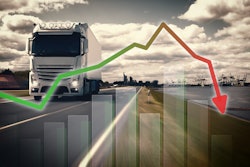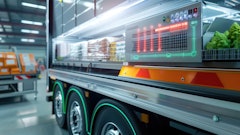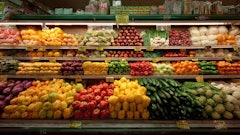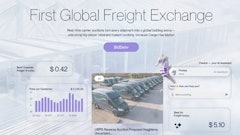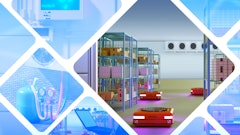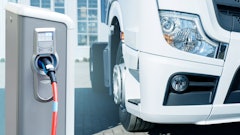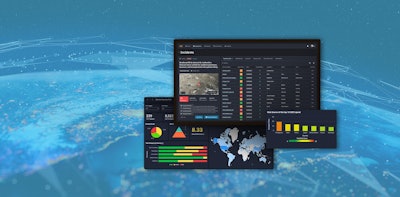
The influx in cargo theft, cybersecurity concerns and ever-changing industry regulations continue to threaten the safety and security of tomorrow’s supply chains.
But, when it comes to the State of the Supply Chain, the implementation of technology mixed with the ability to be flexible, nimble and versatile will enable the logistics world to pivot accordingly.
Marina Mayer, editor-in-chief of Food Logistics and Supply & Demand Chain Executive, talks exclusively with Julie Gerdeman, CEO of Everstream Analytics, about climate change, driver strikes, temperature-controlled products and why AI supplier mapping and monitoring are key to mitigating risk in the future.
CLICK HERE to read the article in full.
Food Logistics: From your perspective, what are considered the Top 5 trends to watch in 2024? And why?
Julie Gerdeman: In 2024, food and beverage producers, manufacturers, distributors, and logistics partners will continue to face a convergence of ecological, geopolitical, and economic risks. These distinct but interlocking crises include unprecedented climate and weather extremes, escalating geopolitical conflict, and ongoing labor shortages. Bolstering operational efficiencies and resilience, demonstrating regulatory compliance, and accelerating sustainability efforts will remain board-level imperatives, and companies will need to prioritize digital transformation and embrace automation and AI to manage the increasing demands.
· One of the most immediate threats to the food industry is extreme weather, which is causing widespread fires, flooding, and drought, leading to agricultural losses, and prompting countries to take an isolationist approach to their food supply, cutting off exports of critical foodstuffs like grains, sugar, rice, and edible oils.
· An unpredictable geopolitical landscape is another major risk for the industry. War and trade restrictions will continue destabilizing food chains and exacerbating global food shortages.
· Increased scrutiny of environmental and labor implications in global food supply chains will further disrupt the industry as forced, and child labor allegations, ecological degradation, and current and emerging supply chain regulations will lead to production halts and sourcing issues of critical ingredients and inputs.
· Cyber-attacks will become more prevalent as the industry transitions from manual labor to increased automation and digital operations management. As well as an increase in the number of attacks, we're seeing an increase in the impact and sophistication of attacks, which can have severe consequences on the availability and safety of temperature-sensitive food products. Cyber risks have shifted from a technology issue to a business risk, with attacks causing significant disruptions to operations and millions in losses.
· Companies are looking to their supply chains as they race to deliver on their net zero commitments by 2030. In many sectors, Scope 3 emissions can account for up to 80% of a company's total emissions. Lowering Scope 3 presents one of the most significant opportunities for decarbonization, and the industry will look for opportunities to gain operational efficiencies. For example, our clients are using our analytics to optimize the mode, route, and equipment selection for temperature-sensitive goods, saving money by protecting products from freezing or spoilage, reducing refrigeration costs when cold blankets do the trick, reducing fuel costs, and lowering their carbon emissions.
Food Logistics: Describe some of the challenges impacting many of today's supply chains.
Gerdeman: Climate change is not only an ESG issue; extreme weather can also seriously hurt a company's bottom line. Weather disasters are one of the most disruptive supply chain events, and the number of incidents has increased exponentially with climate change. From soaring olive oil pricing due to drought in Europe and soda companies struggling to source the CO2 to floods causing factory outages and low water levels slowing the transportation of goods on the Rhine and Mississippi Rivers, weather impacts commodities production, manufacturing operations, and transportation.
Geopolitical conflict and trade tensions are another leading risk to supply chain operations. Financial sanctions, trade restrictions, military operations, and airspace shutdowns can swiftly impact access to key commodities and materials and destabilize entire supply networks. An example of this is the Russian invasion of Ukraine, where ongoing conflict and the Black Sea Grain Initiative's collapse continue to threaten global grain and corn supplies. With the escalating conflict in the Middle East, we are seeing major production disruptions due to closed military zones covering several towns which are home to around 800 companies from a variety of sectors, including the manufacturing, food and beverage, and electronics industries.
Manufacturers need to understand and proactively address the weak points in their supply chains to adapt their operations to respond to immediate and long-ranging risks. This requires complex multi-tier supply network mapping, ongoing monitoring, scenario modeling and risk scoring, and ongoing monitoring across the network - from raw material to the store shelf. With the right visibility and predictive intelligence, companies can anticipate temperature extremes and how climate change will impact operations and supply in the near term and 30 years out. They can understand supply concentration and put contracts into place now to ensure consistent supply in the case of a shortage or switch suppliers in the face of disruptions, providing a first-mover advantage.
Food Logistics: Describe the State of Transportation and how factors such as union strikes, driver shortage, etc. will affect the State of Transportation in 2024.
Gerdeman: Several prolonged strikes have caused ripple effects throughout the global supply chain. Due to the perishable nature of food, labor actions can have devastating effects on the food industry as any resulting delivery delays or production disruptions can lead to total loss of product. Though the ILWU west coast port strike has concluded, it led to immense disruptions in many industries in 2023. As union-supported labor action gains more ground, especially on the heels of the ILWU win, further strike action by transportation and logistics workers (including railway and airport workers) will likely occur.
The ongoing shortage of truck drivers has been well documented and will continue to make it increasingly difficult to get products from ports to store shelves and drive up prices, as will bankruptcies like Yellow Corp., a once-dominant US trucking company.
Prolonged issues with shipping through the Panama Canal will continue to disrupt the transport of dry bulk goods such as grains and soybeans well into 2024. The El Nino climate event has decreased water levels in the lakes that feed the Canal to a point where Panamax and neo-Panamax vessels have been limited in their permitted weight and volume of goods. Though less perishable than fruits, vegetables, and meats, dry goods are also at risk of eventual loss due to significant congestion and delays transiting the Canal.
While a relatively environmentally friendly mode of transportation, the ocean shipping industry still contributes around 2-3% of global emissions. The International Maritime Organization (IMO) has set a goal to reduce shipping emissions by 50% compared to 2008 levels by 2050. This means the industry must accelerate decarbonization initiatives while managing strikes, labor shortages, weather, and geopolitical disruptions.
Everstream is supporting the implementation of green corridors through AI-powered intermodal logistic data cleansing and carbon intensity measurement and reporting. Our emissions baseline measurement, analytics, and monitoring span all aspects of cargo handling across shipping lines, intermodal carriers, and other transshipment points to help ports and shippers balance shipping time, expense, and environmental impact to save money while creating truly sustainable corridor operations.
Food Logistics: Describe the State of E-Commerce and how the B2B and B2C channels in cold chain have thrived/declined since the onset of COVID.
Gerdeman: Historically, there has been very little oversight of last-mile distribution for cold chain shipments. There are three primary reasons for this:
1. There is little to no regulatory oversight, pressure, or compliance.
2. Maintaining appropriate environmental conditions in the last mile of distribution is challenging.
3. The last mile tends to be of comparatively short time duration and distance traveled compared to earlier supply chain stages.
As such, there are general views that little harm can be done to the product. Unfortunately, this commonly held view is inaccurate.
Temperature excursions will often happen in later distribution stages simply because controlling environmental conditions in the last mile is far more complicated. The pandemic raised awareness for the general public about the importance of maintaining appropriate cold chain management programs. Think back to the challenges of distributing the COVID-19 vaccine: Pfizer's vaccine was distributed on dry ice (i.e., -80°C), and Moderna's vaccine was stored frozen (below -30°C). If a vaccine is adulterated to the point where efficacy is negatively impacted, it could mean the difference between life and death, particularly for those who were in high-risk groups.
As people huddled in their homes during the pandemic and business models morphed to adopt more customer-friendly and efficient home-delivery models, the importance of quality control in the last mile of distribution made its way to board room discussions. Home delivery of groceries and the cost of shrinkage due to temperature abuse are essential factors in grocery retailers' overall profitability. Customer complaints about home delivery of prepared foods only increase customer churn. Given many of these businesses are primarily regional/local, a lost customer is meaningful because it results in lower market penetration – driving the customer to the competition.
For pharmaceuticals, the same is true. The consumer is now much more educated, and their expectations are higher related to mail-order pharmacy or delivery by their local CVS, Walgreens, etc. The market has changed. People order food on apps like Toast and through Whole Foods/Amazon – now with free delivery, which is not hard to do in this highly inflationary environment. The high expectations for convenient last-mile delivery of quality foods and medicines are not going away. The pandemic has changed consumer expectations and improved cold chains, but there remains plenty of opportunity for improvement.
Food Logistics: Describe the State of Software and Technology and how AI, robotics, and more are shaping the future of the cold food chain.
Gerdeman: Technology is evolving rapidly in the cold chain industry, and the pandemic has helped to increase investment and expedite developments, improving overall cold chain management. While real-time in-transit monitoring technology has been around for a long time, the pandemic dramatically increased the use of this technology, helping to drive down costs and increase the pace of adoption. In fact, the cost of real-time technology is approaching that of conventional dataloggers just a few years ago. This is particularly true if you factor in some modest recycle and reuse modeling into the overall cost factor.
However, this technology is a small component of the overall picture. While there is a strong focus on real-time in-transit visibility for high-value and temperature-sensitive goods, very little can be done when something goes wrong in transit. While there are opportunities to take corrective actions and avoid a temperature excursion, success depends on many factors and, in practice, is very challenging.
The real value add of this technology is in enabling the wireless download of the environmental conditions experienced in transit. It is common to find that the time and temperature data is never downloaded. It is simply too time-consuming to locate the monitor in the shipment and physically initiate a download of the data. This is particularly true in the food sector. Unless the monitor is alarmed, the data collected by the monitor is never downloaded and stored. Adopting wireless technology guarantees that the full-time and temperature graph will be available because the manual downloading process is virtually eliminated.
Everstream provides a more comprehensive predictive view of broader supply chain risks and opportunities to drive operational optimization, cost savings, and overall risk reduction. The value is in optimizing time, mode, packaging, and in-transit service levels up front over trying to fix problems in transit. By analyzing multiple datasets, including cold chain data, lane risk assessments, historical LSP performance data, import/export records, etc., we enable proactive supply chain risk mitigation.
Food Logistics: Describe the State of Sustainability and what's in store for supply chains come 2024 with certain ESG regulations coming down the pipeline.
Gerdeman: Governments worldwide are adopting legislation to ensure businesses can’t turn a blind eye to exploitation in their supply chains. We see this with the UK Anti-Slavery Act, the US Uyghur Forced Labor Prevention Act, known as UFLPA, the German Supply Chain Act, the Japanese National Action Plan, and the upcoming EU Supply Chain Act. These regulations include due diligence obligations to counter all forms of forced labor. They hold companies responsible when exploitative labor practices are found anywhere in their supply chains.
In most cases, companies don’t know they have a problem because the issue lies deep within their supply chains, in their Tiers 2, 3, and beyond. One of the biggest challenges is mapping complex sub-tier supplier relationships, which we do with our Discover solution. Then our AI analyzes massive amounts of data, including media alerts and risk signals to uncover forced labor risk at the product and location level.
We’re working with a life sciences company that came to us to understand their UFLPA sub-tier supplier risk. They gave us a list of nearly 10,000 Tier 1 suppliers, which would be impossible to analyze manually, but our AI analysis found 105 at risk. Of those, 26 unique suppliers worked with companies that matched to the UFLPA watchlist. This information helped our client pinpoint areas of risk to make responsible sourcing decisions that protect human rights and its business.
Carbon and emissions data is becoming increasingly important in mode and routing decisions, and carriers providing lower carbon equipment and transport will have a competitive advantage. It won’t just be in earning reports. Governments are already creating requirements around carbon emissions, and many companies have their own targets they need to reach by 2030. Reliable data will allow them to broadly communicate their performance for compliance and to market their commitment to sustainability.
Food Logistics: Looking back at the past 2-3 years, how has the cold food chain progressed? Declined? What's in store come 2024?
Gerdeman: The need to respond dynamically to changes in transportation reliability and environmental conditions has increased. Transportation disruptions and delays are increasing, and more disruptive weather events and temperatures are occurring. Leveraging and integrating tools to expedite decision-making and automate changes is necessary to get and stay ahead.
With regulations and consumer interest growing about carbon emissions reductions, this will become a focus with a needed effort to track, reduce, and offset carbon production.
Food Logistics: What are some things not addressed above that may be pertinent to our readers?
Gerdeman: The transportation sector, including trucks, aircraft, ships, and passenger cars, is the leading contributor to CO2 emissions in the United States. This fact highlights the urgent need to shift towards electric vehicles (EVs). However, transitioning to EVs requires a significant transformation of the global supply chain for lithium-ion batteries, which are essential for powering environmentally friendly vehicles and equipment.
We work with some of the world's leading automotive and heavy equipment manufacturers whose entire supply chains are changing as they move from internal combustion engines to EV. With added materials to source, new environmental and sustainability concerns to grapple with, and a host of new, often untested, component suppliers; AI supplier mapping and monitoring will be key to managing the risks inherent in this major supply chain shift.
Additionally, everyone is thinking a lot about generative AI, the potential to reshape innovation, to solve seemingly impossible business problems and world challenges like climate change and forced labor, and what it means for current and future generations of workers. There is no question that generative AI has triggered a rebirth of curiosity and possibility, especially within supply chain.
Now, more than ever, we need to become curious. We must foster cultures of curiosity and be open to using data and technology to dig more deeply to produce the creative solutions needed for the increasingly complex and multi-faceted problems we face. Leading companies are shifting their supply chain tracking and management solutions toward integrated global solutions over previously siloed regional systems. This will give them visibility into the entire network and the ability to understand and mitigate the risks that could impact that network both upstream and downstream. This end-to-end perspective also gives them a view of opportunities to optimize operations, gain a first-mover advantage, and improve ESG performance, ultimately creating more resilient, sustainable supply chains worldwide.
CLICK HERE to read the article in full.






